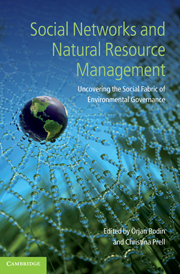 Social Networks and Natural Resource Management
Social Networks and Natural Resource Management Book contents
- Frontmatter
- Contents
- Contributors
- Foreword
- Part I Introduction
- 1 A social relational approach to natural resource governance
- 2 Some basic structural characteristics of networks
- 3 Combining social network approaches with social theories to improve understanding of natural resource governance
- Part II Case studies
- Part III Summary and outlook
- Index
- References
1 - A social relational approach to natural resource governance
from Part I - Introduction
Published online by Cambridge University Press: 05 June 2012
- Frontmatter
- Contents
- Contributors
- Foreword
- Part I Introduction
- 1 A social relational approach to natural resource governance
- 2 Some basic structural characteristics of networks
- 3 Combining social network approaches with social theories to improve understanding of natural resource governance
- Part II Case studies
- Part III Summary and outlook
- Index
- References
Summary
The social dimension of sustainable development
The magnitude of the impact of human activities on the natural environment is now on a planetary scale (Vitousek et al., 1986; Rockström et al., 2009). The growth of the human population and the growth in amount of natural resources used are altering the Earth in unprecedented ways (Lubchenco, 1998), while humanity at the same time is fundamentally dependent on Earth system processes for a prosperous societal development (Rockström et al., 2009). Hence, natural resource extraction and environmental impact have a deeper meaning than simply correcting for externalities. People are embedded in Earth system processes, dependent on the capacity of ecosystems to generate ecological services for societal development. Therefore, the very notion of “natural resources,” as the term is being used in this book, does not only include single extractable resources such as, for example, fish, timber, and minerals; instead natural resource are also perceived in the much broader context of biophysical processes and ecosystem services (see Daily, 1997; Chapin et al., 2010).
- Type
- Chapter
- Information
- Social Networks and Natural Resource ManagementUncovering the Social Fabric of Environmental Governance, pp. 3 - 28Publisher: Cambridge University PressPrint publication year: 2011
References
- 16
- Cited by


